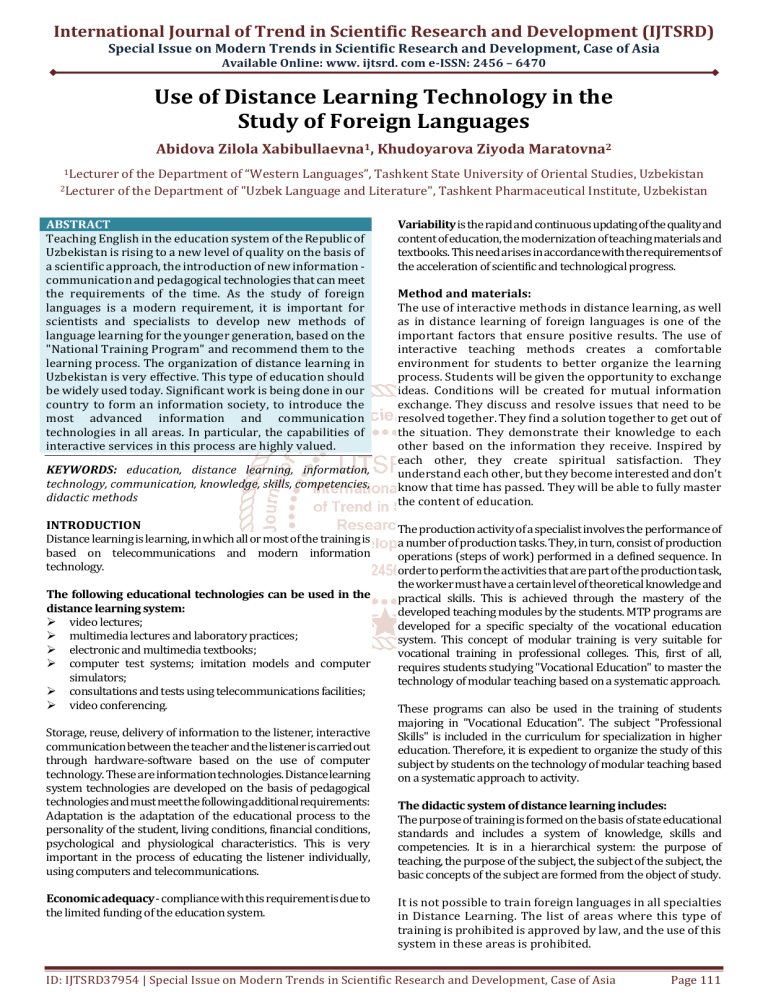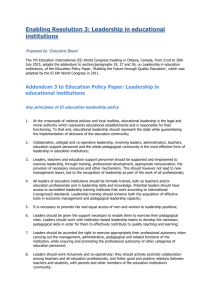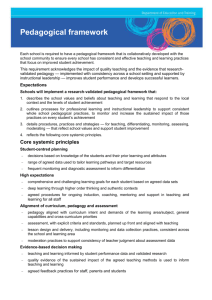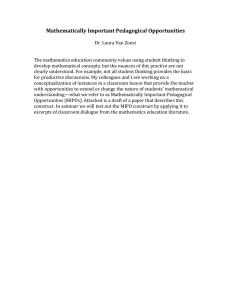
International Journal of Trend in Scientific Research and Development (IJTSRD) Special Issue on Modern Trends in Scientific Research and Development, Case of Asia Available Online: www. ijtsrd. com e-ISSN: 2456 – 6470 Use of Distance Learning Technology in the Study of Foreign Languages Abidova Zilola Xabibullaevna1, Khudoyarova Ziyoda Maratovna2 1Lecturer 2Lecturer of the Department of “Western Languages”, Tashkent State University of Oriental Studies, Uzbekistan of the Department of "Uzbek Language and Literature", Tashkent Pharmaceutical Institute, Uzbekistan ABSTRACT Teaching English in the education system of the Republic of Uzbekistan is rising to a new level of quality on the basis of a scientific approach, the introduction of new information communication and pedagogical technologies that can meet the requirements of the time. As the study of foreign languages is a modern requirement, it is important for scientists and specialists to develop new methods of language learning for the younger generation, based on the "National Training Program" and recommend them to the learning process. The organization of distance learning in Uzbekistan is very effective. This type of education should be widely used today. Significant work is being done in our country to form an information society, to introduce the most advanced information and communication technologies in all areas. In particular, the capabilities of interactive services in this process are highly valued. KEYWORDS: education, distance learning, information, technology, communication, knowledge, skills, competencies, didactic methods INTRODUCTION Distance learning is learning, in which all or most of the training is based on telecommunications and modern information technology. The following educational technologies can be used in the distance learning system: video lectures; multimedia lectures and laboratory practices; electronic and multimedia textbooks; computer test systems; imitation models and computer simulators; consultations and tests using telecommunications facilities; video conferencing. Storage, reuse, delivery of information to the listener, interactive communication between the teacher and the listener is carried out through hardware-software based on the use of computer technology. These are information technologies. Distance learning system technologies are developed on the basis of pedagogical technologies and must meet the following additional requirements: Adaptation is the adaptation of the educational process to the personality of the student, living conditions, financial conditions, psychological and physiological characteristics. This is very important in the process of educating the listener individually, using computers and telecommunications. Economic adequacy - compliance with this requirement is due to the limited funding of the education system. Variability is the rapid and continuous updating of the quality and content of education, the modernization of teaching materials and textbooks. This need arises in accordance with the requirements of the acceleration of scientific and technological progress. Method and materials: The use of interactive methods in distance learning, as well as in distance learning of foreign languages is one of the important factors that ensure positive results. The use of interactive teaching methods creates a comfortable environment for students to better organize the learning process. Students will be given the opportunity to exchange ideas. Conditions will be created for mutual information exchange. They discuss and resolve issues that need to be resolved together. They find a solution together to get out of the situation. They demonstrate their knowledge to each other based on the information they receive. Inspired by each other, they create spiritual satisfaction. They understand each other, but they become interested and don't know that time has passed. They will be able to fully master the content of education. The production activity of a specialist involves the performance of a number of production tasks. They, in turn, consist of production operations (steps of work) performed in a defined sequence. In order to perform the activities that are part of the production task, the worker must have a certain level of theoretical knowledge and practical skills. This is achieved through the mastery of the developed teaching modules by the students. MTP programs are developed for a specific specialty of the vocational education system. This concept of modular training is very suitable for vocational training in professional colleges. This, first of all, requires students studying "Vocational Education" to master the technology of modular teaching based on a systematic approach. These programs can also be used in the training of students majoring in "Vocational Education". The subject "Professional Skills" is included in the curriculum for specialization in higher education. Therefore, it is expedient to organize the study of this subject by students on the technology of modular teaching based on a systematic approach to activity. The didactic system of distance learning includes: The purpose of training is formed on the basis of state educational standards and includes a system of knowledge, skills and competencies. It is in a hierarchical system: the purpose of teaching, the purpose of the subject, the subject of the subject, the basic concepts of the subject are formed from the object of study. It is not possible to train foreign languages in all specialties in Distance Learning. The list of areas where this type of training is prohibited is approved by law, and the use of this system in these areas is prohibited. ID: IJTSRD37954 | Special Issue on Modern Trends in Scientific Research and Development, Case of Asia Page 111 International Journal of Trend in Scientific Research and Development (IJTSRD) @ www. ijtsrd. com eISSN: 2456-6470 Learners: The naming of learners in the distance learning system has not yet been determined. Sometimes they are called listeners. The distance learning system requires adequate training of students and technical support of jobs. Teachers: These teachers, mainly the effectiveness of the organization of the educational process will depend on them. However, the features of the didactic system of distance learning require different types of Roman functions, versatility, and diversity of roles in the activities that teachers perform. Result and Duscussion: The main purpose of the use of interactive methods in distance learning of foreign languages is to involve students in the process of active learning, to help them develop knowledge and research skills. Interactive methods are based on the active relationship between teacher and student, full understanding of each other. The ultimate goal of the introduction of interactive methods in the learning process is to organize the interaction of the teacher and the student in the classroom, regardless of the form of the lesson. The teacher needs to engage the students in the problems of the lesson, activate their movement and teach them to master as a result. The interactive method of distance learning is becoming the most necessary method in today's world. For example, I express my opinion on a certain topic. I am interested in the attitude of others, the opinion of others in such a situation, it is interesting to share ideas online, not only from acquaintances, but also from other users who are familiar or unfamiliar with the Internet. Representatives of different nationalities may express different opinions. That's when the general conclusion can be drawn. The interactive method can also help to make the topic more understandable. Feedback is the choice of a specific topic. A simple example can be found in the comments we make on this topic. Now, let's talk about the shortcomings of distance education; The first problem is that distance learning limits communication with people. Given that distance learning may involve participants in different regions (locations), most trainees receive more personal attention and communication from tutors, counselors, and classmates than from traditional education. believe that they have the capacity. Quality distance learning programs engage students through group projects and online discussions. In doing so, teachers will be able to answer students ’questions in a timely manner and evaluate their work on a regular basis, and students will have more opportunities to interact. Another question is whether there will be accuracy in assessing the knowledge of students studying in distance learning courses. You can use any crib from a distance. There are no restrictions for him. One of the next problems is time. You don't have time to study. You will have the opportunity to study at special times. The problem may be with the technology you are using. For example, a breakdown in technology or a slow internet connection can cause you inconvenience. When using an interactive approach in the education system, the teacher encourages the student to actively participate. In some cases, the quality of education may be adversely affected by the student's lack of or shyness, or his or her reluctance to express himself or herself. This, of course, can reduce the effectiveness of education. In order to avoid such situations and to avoid such situations, it is in distance learning that the choice and application of a more interactive method than in other teaching methods helps to achieve the intended goal faster and more effectively. When the learning process is organized on an interactive basis, the student's interaction increases, and the skills of partner and creativity are formed. Skills to work with curriculum, syllabus, textbook, standard norms, manuals, content of the topic are formed. Independent reading, working, mastering the content of education, the text becomes a daily personal affair. The student is accustomed to expressing his / her opinion freely, to defend his / her opinion, to prove it, to confirm it. Most importantly, didactic motives are formed in the learning process. That is, the needs, desires, and aspirations of the student are met. The student's interest in the learning process increases. This will take the student to a higher level in achieving the learning objectives. Now let's talk about the advantages of using interactive methods in distance learning of foreign languages, first of all, it leads to a better mastery of the content of teaching. In due course, educational communication between studentteacher-student is established. the learning material is best remembered through mutual information, retrieval, and processing. Students develop the skills of communication, expression and exchange of ideas. Each student is able to think independently, work, and observe. In interactive lessons, the student not only masters the content of education, but also develops his critical and logical thinking. Conclusion: The term distance education is well known today. Distance education is a new method in the education system of our country, and today this process is receiving serious attention. All universities have computer classes, most of which are connected to the global Internet. Distance learning has the following advantages: 1. Creative learning environment. There are many ways in which a teacher can teach, and students can only read a given material. On the basis of the proposed distance learning, students themselves search for the necessary information in a computer database and ensure that their experiences communicate well with others and work on their own. encourages education. 2. Possibility of independent study. Distance learning includes primary, secondary, tertiary and advanced training. Inspectors with different levels of training can work on their own lesson plans and interact with students at their level. 3. Big changes in the workplace. Distance learning is a form of education that is accessible to millions of people, most notably young people who are learning to be productive. This type of training plays an important role in training. 4. A new and effective tool for teaching and learning. The word "interactive" is English and means "selfemployed." Interactive lessons encourage students to think creatively, to actively express information, to ID: IJTSRD37954 | Special Issue on Modern Trends in Scientific Research and Development, Case of Asia Page 112 International Journal of Trend in Scientific Research and Development (IJTSRD) @ www. ijtsrd. com eISSN: 2456-6470 express ideas freely, to take initiative, to find solutions to problems in groups, to work collaboratively, to express ideas in writing. Nowadays, when it comes to the introduction of new methods or innovations in the educational process, it is understood that interactive methods are used in the learning process. Interactivity is the interaction of two people, that is, the learning process takes place in the form of a conversation, in the form of a dialogue (computer communication) or based on the interaction of the student. Interactivity is the interaction, movement, and interaction that takes place in the student-teacher interaction. The main goal of the interactive method is to create an environment for active, free thinking of the student by creating the most favorable conditions for the learning process. It demonstrates its intellectual potential and enhances the quality and effectiveness of education. Interactive lessons are organized in such a way that no student is left out in the process, that is, they have the opportunity to openly express what they see, know and think. Two-way communication with the distance education system, student interaction. In the process of distance learning, the intensity of the exchange of information between students is higher than the exchange of information between the student and the teacher, so it is necessary to provide e-mail addresses to all participants in the learning process. Allows you to solve multiple problems at once when using the interactive method. Most importantly, it develops students' communication skills. Choosing an interactive method of distance learning in foreign languages is a good idea. Because the interactive method of teaching serves to activate the acquisition of knowledge by students, the development of personal qualities by increasing the activity between students and the teacher in the educational process. The use of interactive methods helps to increase the effectiveness of the lesson. With this in mind, we can say that. The interactive method leads to many positive results in the process of distance learning foreign languages. The use of interactive methods in the distance learning of foreign languages enhances the participation of students, encourages them to achieve maximum results. Interactivity also helps teachers incorporate more complex material into the course. Of course, the organization of interactive lessons has its drawbacks. These are learning processes that take a lot of time. Not all students have the opportunity to be supervised in interactive classes. When studying very complex materials, students are not able to solve the problem completely and clearly, and in such situations, the role of the teacher is low. Due to the participation of weak students in the learning process in groups, even strong students get low scores or grades. List of used literature: [1] Ochilov M. New pedagogical technologies. - Karshi.: Nasaf, 2000. [2] Tolipov O., Usmonbaeva M. Applied bases of pedagogical technologies. -T.: 2005. [3] Azizxodjayeva N. N. Pedagogical technology and pedagogical mastery. -Tashkent: Finance, 2002. [4] Azizxodjayeva N. N. Pedagogical technology and pedagogical skills - T.: Science, 2006. [5] Yuldashev JG, Usmanov S. Advanced pedagogical technologies. - T.: Teacher, 2004. [6] Khodjayev N. H., Khodiyev B. Yu., Baubekova G. D., Tilabova N. T. New pedagogical technologies. Study guide. - T.: Fan, 2002.p-38. [7] Ruzimurodov O.N. Haydarov T. Technologies and principles of distance learning. - T.: Istiqlol. 2006. [8] Safarov A. Bakhramov K. Non-traditional lessons and interactive methods of teaching. - Bukhara. 2004. [9] Sayidahmedov N. New pedagogical technologies. - T.: Finance. 2003 ID: IJTSRD37954 | Special Issue on Modern Trends in Scientific Research and Development, Case of Asia Page 113



